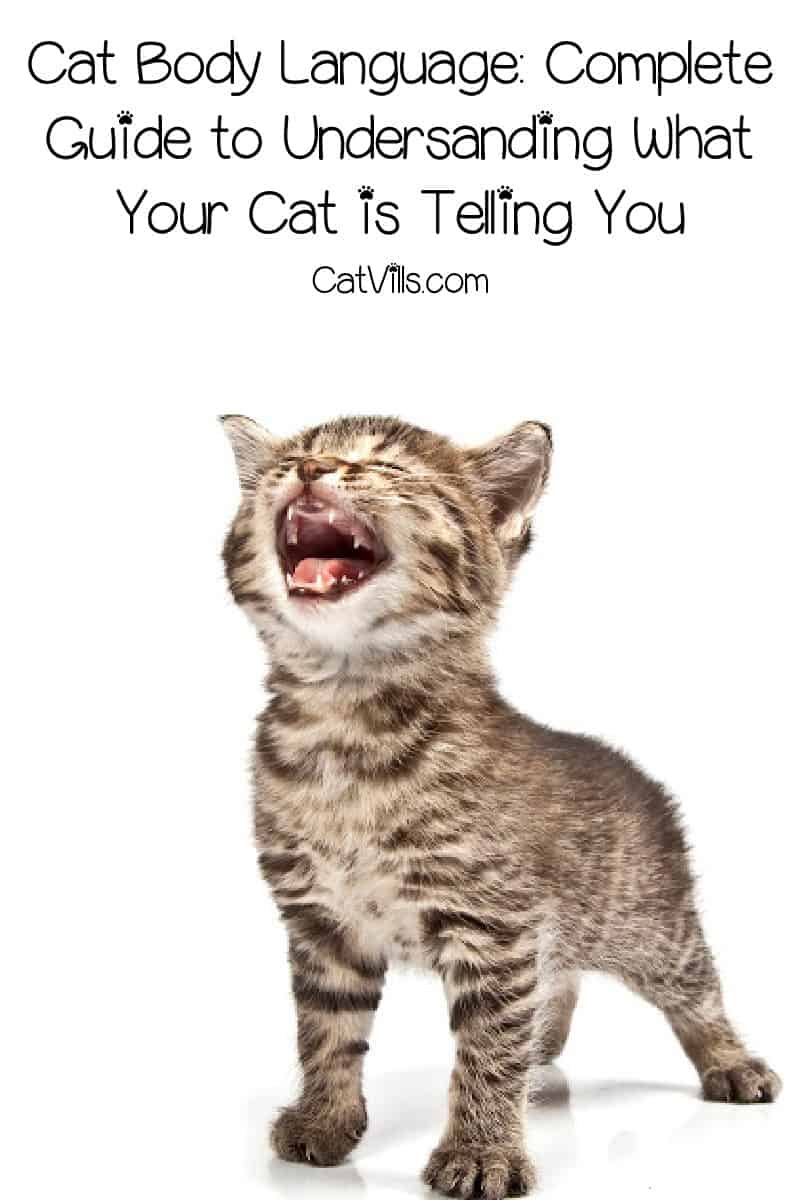Last Updated: 2 years ago
Understanding cat body language is the first step towards really communicating with your feline friends.
In fact, it’s the best way to really grasp your cats’ thought processes and learn vital clues about their needs.
Below, we’ll go over everything you need to know, from what areas to watch to what different signals mean.
We have a lot to cover, so let’s dive right in.
Cat Body Language Explained

Cat body language is a combination of both physical and environmental cues.
Through this language, they let us and other animals know exactly how they’re feeling.
Unfortunately, not all cat owners understand what their cat is trying to say to them.
To have a great relationship with our cats, we need to be able to understand what their bodies are saying to us.
This means understanding how they move and what those movements mean in certain contexts.
Today, we’re going to talk about cat body language to give you a better idea of what your cat is trying to tell you at any given time.
Cat Body Language Areas
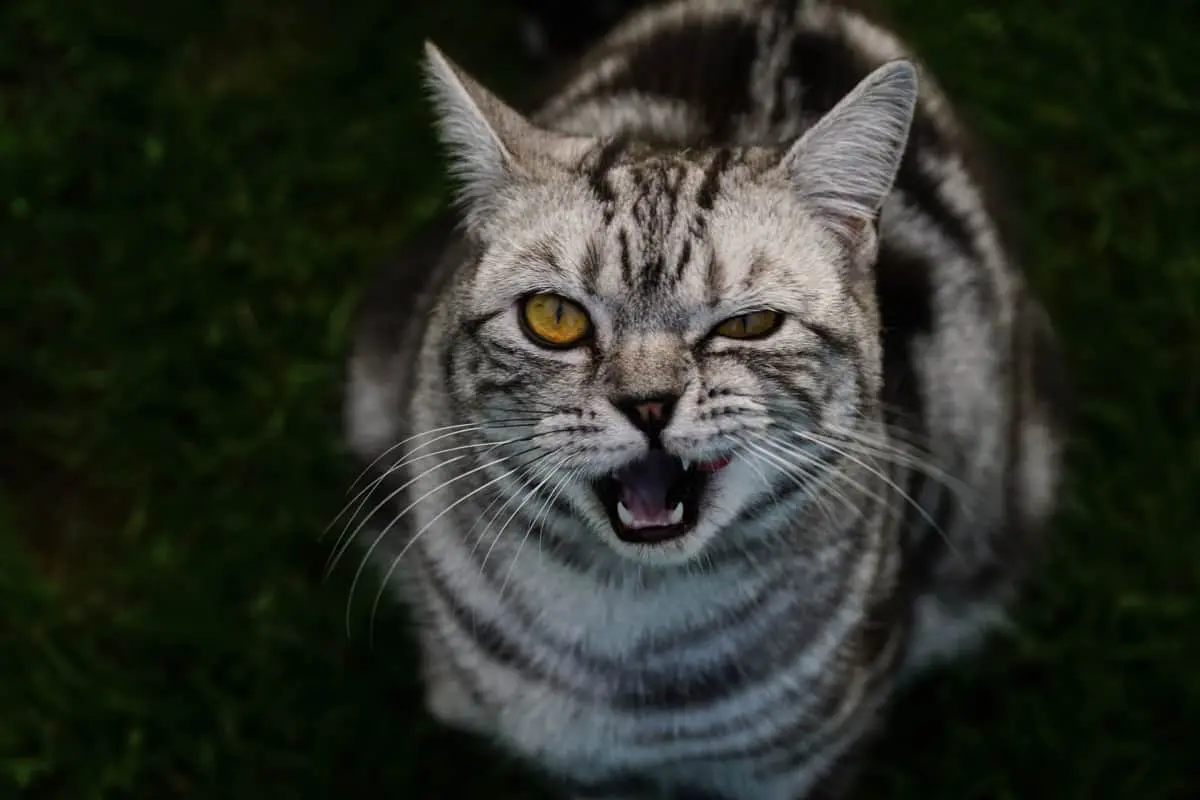
Cats communicate using five specific areas of their bodies: their bodies overall, their tails, their ears, their eyes, and their mouths.
Each of these areas conveys something different to anyone watching them.
Understanding these body areas and what their various signs mean is key to getting inside your cat’s head and really understanding what she’s trying to say to you.
1. The Body

Cats use their bodies as a whole to convey certain messages.
While some of these positions are simply a byproduct of sleeping or relaxation, some of them are intentionally used to convey a very specific feeling or intent.
It’s easiest to read the body because you can get a view of the entire cat as she assumes these positions.
- Laying on one side: When your cat is laying on her side, she’s content and quite relaxed. You’ll often see this position when your cat is sleeping or otherwise extremely calm.
- Laying belly with tucked-under legs: Often referred to as “the loaf position“, this is an alert yet relaxed body position. Your cat isn’t on high alert, but she does have her head upright so she can watch the goings-on in the house.
- Body close to the ground with coiled legs and head forward: If your cat is low to the ground with her head forward, her eyes focused, and her legs coiled up, she’s hunting. Whether it’s a toy or a rodent, she’s gearing up to pounce.
- Low crouch with wide eyes: This position is a sign of intense anxiety. In this position, your cat is trying to make herself smaller to avoid detection.
- Lying on back with curled front paws: This is the position of a happy kitty. This is a cat who’s living her best life. Be aware that just because she’s happy doesn’t mean she won’t “attack” your hands. So unless your cat loves belly rubs, resist the temptation.
- The trap: What I like to call the trap—is the above lying in the back position, but adopted by a cat that doesn’t like belly rubs. The cat is calm, but she’s not asking you to rub her belly. She’ll immediately turn into teeth and claws and clamp down if you try to rub that adorable, fluffy tummy.
- Wiggling from side to side on her back while making eye contact: Your cat wants to play. This position is a clear signal that your cat is feeling spunky and looking to blow off some steam.
- High-arched back with standing fur: This is another position related to fear. The opposite of crouching low, your cat is trying to look larger and more intimidating.
- Big stretch with front low and rear high: This is the cat stretch that we all think of when we think of cats. Cats will do this after waking up, to release tension, or when gearing up to initiate play.
- Standing sideways: Standing sideways can be a sign of shyness. When a cat stands in this position, she’s able to immediately run away if she wants.
2. The Tail
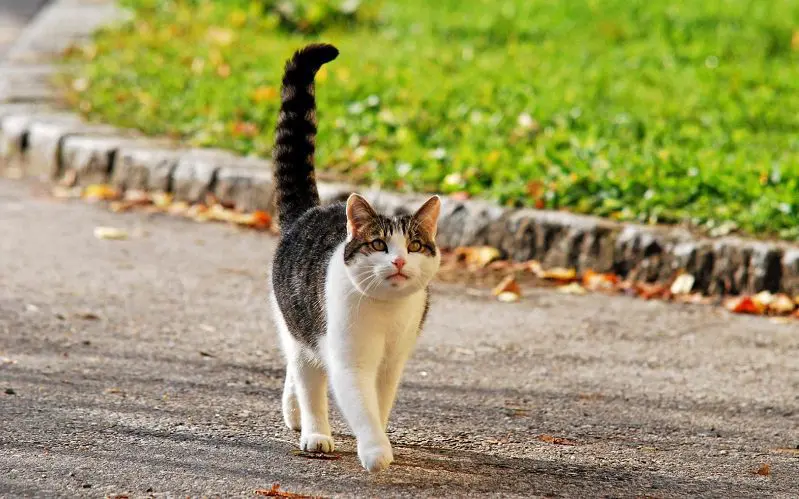
Your cat’s tail will give you a ton of information about how she’s feeling and what she’s trying to tell you. You’ll be surprised at how much cats “say” just by using their tails.
- Straight up: If your cat’s tail is pointing straight up, she’s feeling very happy.
- Straight up and vibrating: This is the cat version of a dog’s tail wagging. It’s a sign that your cat is extremely happy to see you or excited about something.
- Hanging down: If your cat’s tail is hanging down, she’s probably scared or is watching something she thinks is a threat.
- Tucked between legs: Anxious cats will tuck their tails between their legs.
- Slowly wagging: Don’t be fooled by this one. A wagging cat tail is not the same as a wagging dog tail. When a cat slowly wags her tail, she’s sussing out a situation that she’s not sure about.
- Vigorously wagging: A vigorously wagging tail means your cat is extremely agitated.
- Parallel: When a cat’s tail is pointed backward and parallel to the ground, she’s extremely curious about something.
- Straight up with a bent tip: A more subdued version of the straight-up tail, the cat wants to be friends but isn’t sure if the other cat or person is receptive.
- Straight up and puffy: If your cat’s tail looks like a pipe cleaner, she is extremely angry about something.
3. The Ears
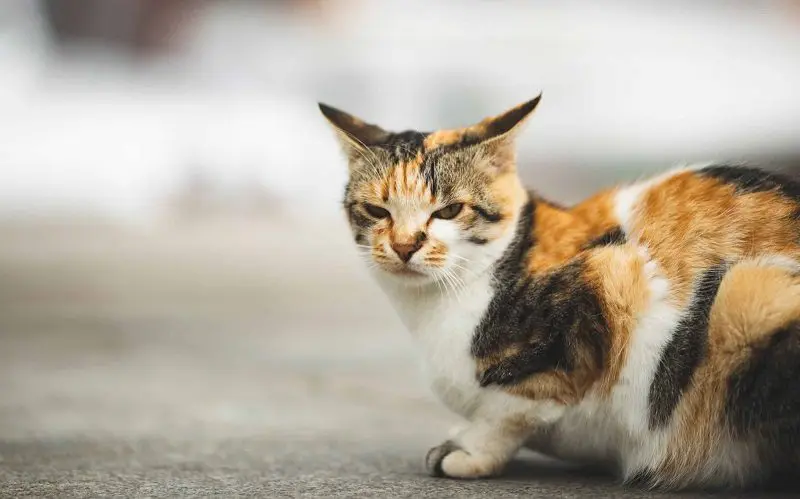
Cats have very expressive ears. They turn in a variety of directions, and each of these directions means something different.
- Forward facing: A content kitty. She’s feeling good and up for whatever.
- Straight up: Upright ears are a sign of high alertness. You might see this if your cat is startled by a noise.
- Sideways: If your cat’s ears are pointed away from her head, she’s nervous about something.
- Backward: This is a sign of irritation.
- Pressed back on the head: If your cat “locks down” her ears flat to her head, she’s either angry or scared.
4. The Eyes
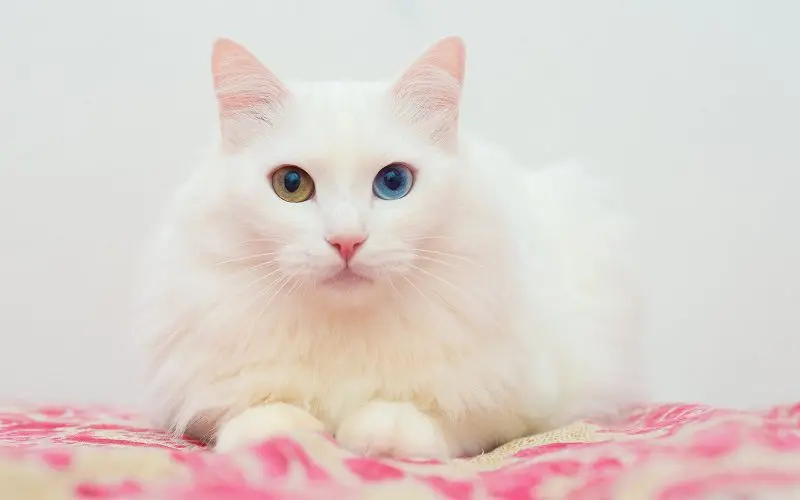
It’s often said that the eyes are the windows to the soul, and when it comes to cat body language, that couldn’t be more accurate.
Your cat’s pupils and eyelids will give you a huge amount of information about how she’s feeling at any given moment.
- Dilated pupils: they can tell you a lot about what your cat is feeling. Dilated pupils combined with a low crouch signals stress. When coupled with rolling on the side and wiggling with the paws up, it’s a sign of playfulness.
- Dilated stare: A stare down with dilated pupils means your cat is in a challenging mood.
- Slow blink: Slow blinks are the kisses of the cat world. It shows affection and trust.
- Half-lidded eyes: Half-lidded eyes are the sign of a relaxed kitty in an environment and around people that she trusts.
- Pinpoint pupils: If your cat’s pupils shrink down to near pinpoints, she could be tense or feeling aggressive.
5. The Mouth
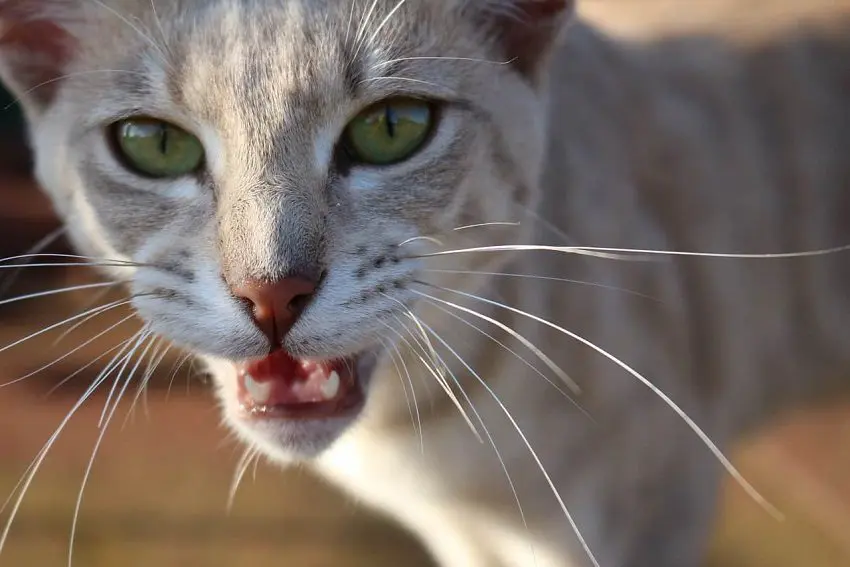
More accurately, the sounds that come out of the mouth. Cats communicate verbally as well as with their bodies, and different sounds mean different things.
- Classic meow: The classic meow usually means your cat wants something – usually food.
- The squeak: The short, squeaky meow that cats sometimes make is their version of saying, “Hey.”
- The rolling R: It’s sort of like a purr on steroids. This sound can start low and rise in pitch. Mothers use this with their kittens, and siblings that live together will often do this.
- Loud, urgent, or both whining meow: This is best described as sort of a kitty siren sound. It’s used by your cat when she’s caught some kind of animal. It’s also sometimes used as a location call.
- Delicate or weak mew: This sound commonly made by kittens is a sign of distress in adult cats.
- Rumbling growl: That deep, rolling growl that seems to come from your cat’s belly means she’s angry or annoyed. It can also be a sign that your cat has spotted something she doesn’t like.
- The purr: The classic purr is a sound of pure contentment. Cats use this purr when they’re feeling great about life and to signal to their owners or other cat friends that they want to hang out.
Putting Cat Body Language Together
Of course, these cat body language cues don’t exist in a vacuum, so it’s important to understand them in context.
Once you understand what these physical and verbal cues mean, it’s easy to recognize what they might mean in the context of your situation.
Of course, life is full of never-ending scenarios, so we’ll touch on some of the most common ones.
For example, if your cat is lying on her back in a relaxed position, but you know she’s not into belly rubs, she’s not inviting you to get in a rub.
She’s simply enjoying life. Another example is when we see kittens arch their backs high into the air with all of their fur standing up.
That’s normally a sign of trying to look imposing to a potential threat, but in kittens, it can also be a way of playing when combined with hopping quickly.
So if your cat sees a strange dog or other cat and adopts this pose, she’s trying to appear intimidating. When your kitten does this and hops around her buddy, she’s saying, “Hey, dummy! Let’s play!”
The best way to understand cat body language is to consider your surroundings and how these various cues work together.
Cats will often display cues from each of the categories above when they’re feeling a certain way.
For example, a frightened cat may arch her back with her hair puffed out, as well as flatten her ears to her head and give the rumbling growl.
Wrap-Up
You’ll be surprised at how quickly you learn to understand what your cat is saying if you combine her body language with the context of what is going on around you.
When you put the two together, you’ll be able to generally understand exactly what your cat is trying to tell you.
So keep all of these key body and body part positions in mind, and you’ll have no problem figuring out what your cat has to say.
What do you think of these tips for understanding cat body language? Share your thoughts below.
